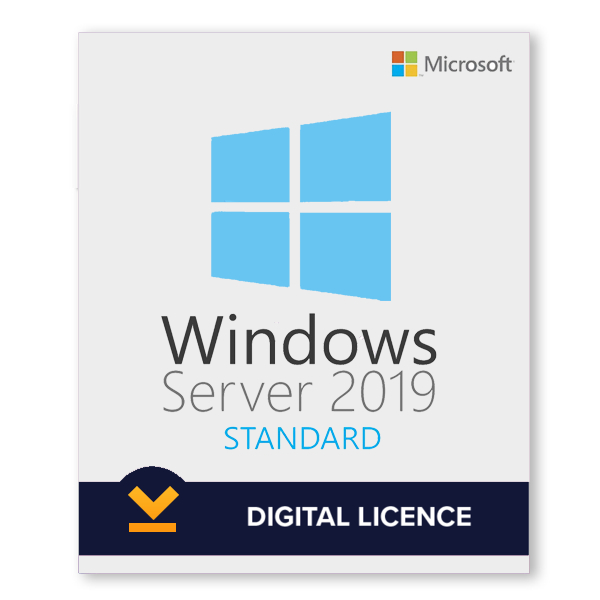
Microsoft Windows Server 2019 Standard License
Why Standard Edition? • Deliver enhancements to core Windows Server functionality. • Enable developers to create cloud native apps and modernize traditional apps using containers and micro-services. • Increase security and reduce business risk with multiple layers of protection built into the operating system. Standard Edition Key Features: • Core Windows Server Functionality. • Hybrid integration. • Up to 2x OSEs/Hyper-V Containers. • Unlimited Windows Server Containers. • Host Guardian Service. • Up to 2TB Single Volume Storage Replica. Datacenter and Standard Edition per-Core Licensing Windows Server 2019 Datacenter and Standard editions are licensed by physical core. Licenses are sold in 2-packs and 16-packs. Full Compliment of Features in Microsoft Server 2019* Fully Supports: • Cluster-Wide Monitoring: Monitors memory and CPU usage, storage capacity, IOPS, throughput, and latency in real time with clear alerts when something's not right. • Cluster Sets: Allows you to create large scale-out clusters with greater flexibility (deploying and retiring clusters) without sacrificing resiliency. • Cluster OS Rolling Upgrade: Enables an administrator to seamlessly upgrade the operating system of nodes in a failover cluster from Windows Server 2012 R2 and Windows Server 2016 to Windows Server 2019 Standard • Mixed OS Mode Cluster: Enables Windows Server 2012 R2 cluster nodes to operate with Windows Server 2016 nodes. • Site-Aware Failover Clusters: Groups nodes in stretched clusters based on physical location, enhancing key cluster-lifecycle operations such as failover, placement policies, heart-beating between nodes, and quorum behaviour. • Kernel Soft Reboot: Provides WSSD-validated hardware faster reboot time, reducing application downtime. • Persistent Memory: Support for persistent memory (PM) technology provides byte-level access to non-volatile media while also reducing the latency of storing or retrieving data significantly. • Linux and FreeBSD Workloads: Enables most of the Windows Server software-defined datacenter features for Linux and FreeBSD guests running on Hyper-V for increased functionality, performance, and manageability. • Hot Add and Remove for Disk, Memory, and Network: Add or remove a network adapter and adjust the amount of memory assigned while the VM is running, without any interruption. The memory adjustment capability works even when you have dynamic memory turned on for a Hyper-V host. • Network Controller: Provides a centralized, programmable point of automation to manage, configure, monitor, and troubleshoot virtualized network infrastructure in your datacenter. • Virtual Networking: Helps create network overlays on top of a shared multi-tenant physical fabric. • Software Load Balancer (SLB): A cloud-optimized Layer 3 and Layer 4 load balancer that provides both North-South and East-West load balancing. • Virtual Network Peering: Provides high speed connectivity between two virtual networks. Traffic between the virtual networks goes through the underlying fabric network with no gateway. Both virtual networks must be part of the same datacenter stamp. • Distributed Firewall and Micro-Segmentation: Dynamically segment networks based on evolving security or application needs using a stateful firewall and network security groups. • Hybrid SDN Gateways: Multi-tenanted, highly available gateways that connect customer virtual networks to Azure, other Windows Server-powered clouds, high speed WANs, and local non-virtualized resources. • Improved SDN Gateway: Improvements up to 3x for GRE tunnels and IPSec site-to-site VPN. • Converged RDMA: Converge RDMA storage traffic and tenant Ethernet traffic on the same underlying NIC team for significant cost savings, while also getting the desired throughput and quality of service. • Precision Time Protocol (PTP): PTP enables network devices to add the latency introduced by each network device into the timing measurements, thereby providing a far more accurate time sample than Network Time Protocol (NTP). • Leap Second: Support for leap seconds (occasional 1-second additions to UTC to adjust as earth’s rotation slows) increases accuracy, compliance, and traceability. • HTTP/2: Support for HTTP/2 (RFC 7540) in the native HTTP server. Now, Windows Server 2019 delivers performance and security benefits to your website deployments with HTTP/2. • Latency Optimized Background Transport - LEDBAT: With Windows Server 2019, we bring a latency optimized, network congestion control provider, Low Extra Delay Background Transfer (LEDBAT). LEDBAT is designed to automatically yield bandwidth to users and applications, while consuming the entire bandwidth available when the network is not in use. • IP Address Management (IPAM) and DNS: IPAM now supports comprehensive DNS and DHCP management with role-based access control across multiple AD forests. DNS provides for traffic management, load balancing, split-brain deployments, and prevention of DNS amplification attacks. • MultiPoint Services Role: Enables low cost-per-seat by allowing multiple users to run their own sessions while connected to one machine. • High-Availability RDS Connection Broker: helps create a fault-tolerance connection broker for Remote Desktop Services (RDS) scenarios. • SDN with IPv4/IPv6: Software defined networking (SDN) provides a method to centrally configure and manage physical and virtual network devices. Additionally, Windows Server 2019 Standard now supports IPv6 and dual stack IPv4/IPv6 addressing as well. Brand: Microsoft Released on: 08-10-2018 Program type: Windows Server Format: Retail License Key Compatibility: 32-bit and 64-bit Language: EU Multilingual (it is possible to change language settings after installation; additional language packs are also available to be downloaded and installed separately) Product code : P73-07788 EAN/UPC : 0889842425611
| Merchant: | SoftwareSupply.net |